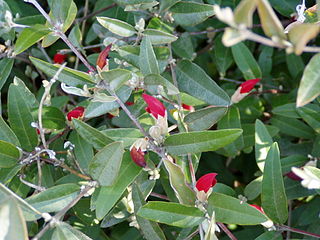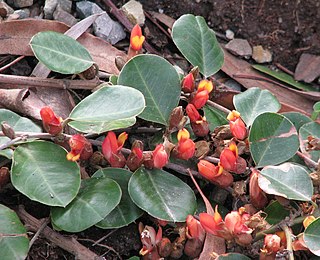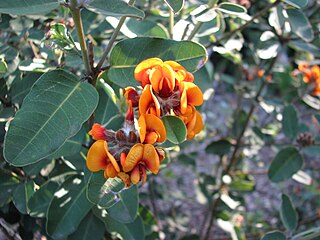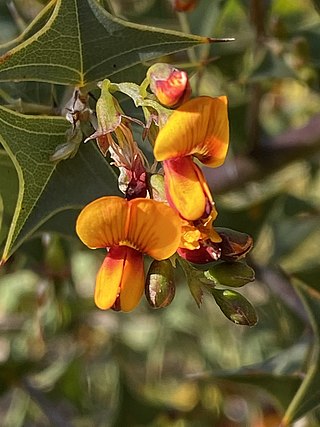
Gastrolobium is a genus of flowering plants in the family Fabaceae. There are over 100 species in this genus, and all but two are native to the south west region of Western Australia.

Gastrolobium melanopetalum is a shrub in the family Fabaceae which is endemic to the south-west of Western Australia.

Gastrolobium praemorsum is a scrambling shrub which is endemic to the south-west of Western Australia. It is a member of the family Fabaceae and produces red pea-flowers from late winter to early summer. It is not known whether this species shares the toxic properties of many other members of the genus Gastrolobium.

Gastrolobium bilobum, commonly known as heart-leaved poison, is a bushy shrub which is endemic to south west Western Australia.

Gastrolobium celsianum, the Swan River pea, is a low-growing shrub which is endemic to Western Australia.

Gastrolobium grandiflorum, commonly known as wallflower poison, wallflower poison bush or heart-leaf poison bush, is a bushy shrub which is endemic to Australia.

Gastrolobium spinosum, also known as prickly poison, is a shrub in the family Fabaceae. It is endemic to Southwest Australia
Gastrolobium propinquum is a shrub in the family Fabaceae, endemic to the Southwest Australia savanna region, which is toxic to many animals. It has been given the common name Hutt River poison.
Gastrolobium lehmannii, the Cranbrook pea, is a vulnerable shrub in the family Fabaceae which is endemic to an area of Western Australia.

Gastrolobium minus, also known as broad-leaved brachysema, is a prostrate shrub which is endemic to the south-west of Western Australia. It is a member of the family Fabaceae and of the genus Gastrolobium, which contains many toxic species, however the toxicity of this species is unknown.

Gastrolobium coriaceum is a shrub species in the family Fabaceae. It is endemic to the south west of Western Australia.

Gastrolobium formosum is a small, trailing shrub, with red flowers, in the pea family (Fabaceae), which grows up to a metre high, on clays and loam in swamps and along river banks. The inflorescence consists of head of four unstalked flowers which is sheathed by a whorl of large bracts, with the flower petals being obscured by the lower calyx lobes. The standard petal is less than on third the keel petal. It is native to the south-west of Western Australia.

Gastrolobium nervosum is a small shrub in the pea family (Fabaceae), native to Western Australia.

Gastrolobium rigidum is a small bushy shrub in the pea family (Fabaceae), native to Western Australia.

Asteridea pulverulenta is a species of flowering plant in the Asteraceae family, which is endemic to Western Australia, in the south-west. It was first described in 1839 by John Lindley.

Gastrolobium trilobum, commonly known as bullock poison, is a flowering plant in the family Fabaceae, and is endemic to Western Australia. It is a small, rigid shrub with orange, yellow and red flowers.

Mirbelia seorsifolia is a species of flowering plant in the family Fabaceae and is endemic to the south-west of Western Australia. It is an erect, open shrub that typically grows to a height of 15–70 cm (5.9–27.6 in) and has yellow and red flowers from August to December. It grows on sandplains in the Avon Wheatbelt, Coolgardie, Great Victoria Desert, Murchison and Yalgoo bioregions of south-western Western Australia. The species was first formally described in 1876 by Ferdinand von Mueller, who gave it the name Gastrolobium seorsifolium in Fragmenta Phytographiae Australiae. In 1943, Charles Gardner changed the name to Mirbelia seorsifolia in Enumeratio Plantarum Australiae Occidentalis. The specific epithet (seorsifolia) means "separate leaves", referring to the well-spaced leaves. Mirbelia seorsifolia is listed as "not threatened" by the Government of Western Australia Department of Biodiversity, Conservation and Attractions.

Gastrolobium stenophyllum, commonly known as narrow-leaved poison, is a flowering plant in the family Fabaceae and is endemic to Western Australia. It is a bushy, upright shrub with orange, pink and red flowers. Flowering occurs from September to December or January to February. It grows at the base of outcrops, near rivers, in heath and shrubland and in sandy locations.
Spyridium villosum is a species of flowering plant in the family Rhamnaceae and is endemic to the south-west of Western Australia. It is a small shrub with shaggy-hairy branchlets, linear to oblong leaves and dense heads of hairy flowers with broad brown bracts at the base.

Gastrolobium calycinum commonly known as York Road poison,is a flowering plant in the family Fabaceae. It has variable leaves and yellow pea flowers with a pink or red centre and is endemic to Western Australia.


















